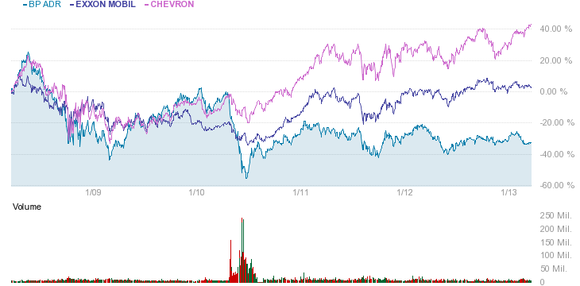Every now and then, seemingly unjustified pullbacks can gift bold investors with significant price reductions, increased yields, and more favorable long term returns. Recently, European oil stocks have suffered amid renewed fears that austerity’s harsh economic effects will linger. But when quality companies with inelastic products and global demand suffer major declines, they can often offer long-term value investors an ideal entry point.

Poshly Refined
Over the last 45 days, BP plc (ADR) (NYSE:BP) shares have slid 10%. But the majority of BP plc (ADR) (NYSE:BP) analysts have held firm on their outlook for fiscal 2013 and 2014.
This London-based company has put the Deepwater Horizon (DH) tragedy largely behind it, and is poised for a solid future. Fifteen projects are scheduled for completion in the coming two years. Two more projects were started in Q4 of 2012, for a total of five new projects last year.

In addition, four new projects are already underway for 2013 in Australia, Azerbaijan, Angola, and the Gulf of Mexico. BP is also the largest leaseholder in the Gulf of Mexico, with more than 700 contracts.
Since the Deepwater Horizon, BP plc (ADR) (NYSE:BP) has a total cumulative net charge of $42.3 billion for damages. This incident has spurred BP to refocus its business by divesting non-core assets. Since 2010, BP has divested a total of $37.8 billion.
“We will continue to see the impact of this reshaping work in our reported results in 2013,” said CEO Bob Dudley. “By 2014, I expect the underlying financial momentum to be strongly evident.”
BP plc (ADR) (NYSE:BP)‘s future looks promising, but what about current valuations? Comparing two top oil companies, Exxon Mobil Corporation (NYSE:XOM) and Chevron Corporation (NYSE:CVX), to BP should give us a better idea.
| Valuation | BP | Chevron | Exxon Mobil |
| P/E | 11.20 | 8.90 | 9.20 |
| Forward P/E | 7.80 | 9.63 | 10.83 |
| Price/Book | 1.09 | 1.70 | 2.40 |
| Price/Sales | 0.34 | 0.98 | 0.82 |
| Yield | 5.30% | 3.00% | 2.60% |
Among the highlights are BP’s forward P/E of 7.80, a price/book of 1.09, and a price/sales of 0.34 — the lowest I found in the industry. Finally, BP’s 5.30% yield is well above the industry average yield of 4.80%.
A quick note on the price/sales figure. Following the DH, BP’s earnings took a huge hit, while sales continued to increase. This caused a historically large divergence between sales and profitability. As BP returns to normal (historic) levels of profitability, we can multiply the current industry average price-to-sales ratio of 0.66 to BP plc (ADR) (NYSE:BP)‘s current revenue of $118/share, and come up with an estimated target price of $78.
Building on the P/S thesis above, comparing sales growth would give another idea of BP’s potential.
| Valuation | BP | Chevron | Exxon Mobil |
| Sales (MRQ) vs Sales One Year Ago | 10.00% | 5.90% | 7.30% |
Combining BP’s sales growth of 10.00% with an expected return to historic profitability makes the potential undeniable.
Examining a five year chart comparing the three, there are some things worth noting.

Exxon Mobil is often touted as a must-own stock, but has remained dead money. While its dividend made for positive gains, its five-year average yield was only 2.30%. With a five-year average inflation rate of 1.99% and a current inflation rate of 1.98%, that yield looks less attractive.
Chevron Corporation (NYSE:CVX) is climbing to record highs. But value investors should be skeptical about chasing performance when fundamentals indicate the stock is becoming expensive.
| Valuations | Chevron | Industry |
| P/E | 9.00 | 9.20 |
| Price/Sales | 0.99 | 0.64 |
| Price/Book | 1.71 | 1.61 |
| Yield | 3.00 | 4.80 |
With the lowest (MRQ) sales increase of the three, higher-than-average P/B and P/S, and a lower than average 3.00% yield, Chevron’s potential seems limited.
